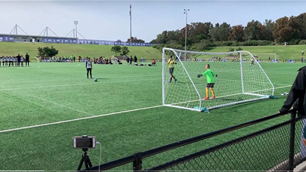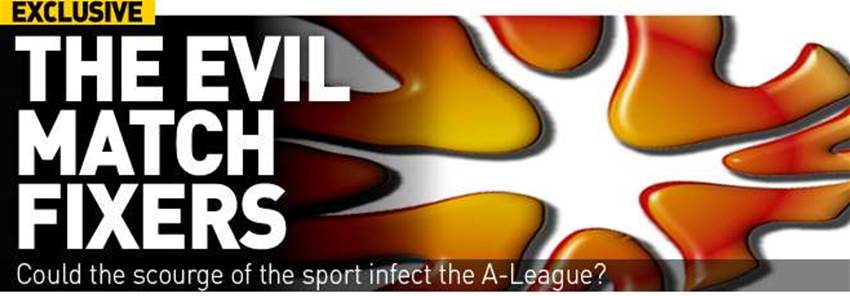VIOLENT gangsters, battered footballers, scared Socceroos and floodlight sabotage – we peer inside the murky world of international match-fixing where the bribery and corruption is more widespread than ever before. Best-selling author Neil Humphreys finds out more...
Former Socceroo Scott Ollerenshaw will never forget the phone call. The outspoken Australian striker, with 18 caps to his name, was becoming a cult hero in the Malaysian M-League. The trouble was he was doing plenty of talking off the pitch. The Sabah striker was disillusioned with the corruption eating the game from the inside out. He spoke out publicly against match-fixing. The response was immediate and threatening.
“During the infamous match-fixing round up all over Malaysia in ’95, I was very vocal in the press about how disgraceful it was,” recalls Ollerenshaw.
“I stressed how it wouldn’t happen in Australia. So, one night, I received a phone call telling me I was a visitor in the country and was advised to keep my mouth shut or else.”
Ollerenshaw, to his credit, continues to live and work in South-east Asia, running his successful Borneo sports holidays and football camp program, and still denounces the endemic corruption as a TV pundit for Astro Supersport in Malaysia.He was threatened, but escaped injury. Other expatriate footballers were not so lucky.
Assaults on Players
In 2000, a tough, non-compromising Yorkshireman was plying his trade in Singapore’s S-League. Some called Max Nicholson a “journeyman” footballer, but that was a lazy, hackneyed description. He was a box-to-box player, closer to Michael Carrick than David Batty. When Nicholson collected the ball, he always went forward, always progressed, always positive. That’s what the match fixers were afraid of. Walking out of his condo one balmy, humid morning on his way to a training session, Nicholson heard a commotion beside him. Several guys jumped out of one of Singapore’s longkangs (open drains) in front of the condo. They wore hockey masks and brandished baseball bats. Nicholson was assaulted in safe, sterile Singapore in broad daylight. He was not going to play for his side, Woodlands Wellington, that weekend. That had already been decided by the match fixers and illegal bookies, chiefly a Mr. Wilson Raj Perumal, but more on him later. Not surprisingly, Nicholson recovered from his injuries and joined his best mate in football, striker Stuart Young, who was having a successful spell up front for Wollongong Wolves in the old NSL. Being a rookie reporter at the time, I covered the Nicholson attack and subsequent match-fixing trial, which served as inspiration for my novel Match Fixer. Nicholson’s attack was a decade ago now, but match-fixing never went away – it got smarter and subtle.
Depressing Reality
Most Australian sportspeople, to their credit, dismiss match-fixing stories and tall tales of crime syndicates spanning the globe with their tentacles sucking the lifeblood from domestic leagues as the stuff of conspiracy theorists. How do you fix 22 players, a bench of substitutes, a referee and his wheezing, often myopic linesmen, two managers, a partisan crowd and the natural elements of wind, rain or dazzling sunshine blinding the cap-less goalkeeper at corners?
The short, depressing answer is – with surprisingly little difficulty. In the 1990s, matches in South-east Asian domestic leagues – such as Malaysia’s M-League or Singapore’s S-League – were fixed in the traditional, old-fashioned way.
Ollerenshaw was involved in fixed matches playing for Sabah in the M-League, but his healthy cynicism held sway initially. He refused to believe. It was un-Australian.
“My first experience with match-fixing came in my second year in Malaysia which was 1995. I had heard a few whispers, but dismissed them. Being an Aussie, it was inconceivable that team-mates could be involved,” he said.
“Then we played an away game against Malacca and half way through the second half, we were down 1-0. I won a penalty and my strike partner who was our penalty taker and playing in the Malaysia national team refused to take it. So I took it and scored.
“Suddenly, we were playing so defensive and my striker partner wouldn’t step over the halfway line. The game ended 1-1.”
The following day, Ollerenshaw accepted how deeply entrenched football corruption was in his adopted country.
“We caught the flight home and upon arriving, six of my team-mates were arrested at the airport, handcuffed and taken away,” he recalled.
“They were under investigation and their phone calls were recorded revealing that the game was fixed for Sabah to draw or lose the game.”
“I never trusted anyone in football from that day on.”
Tony Cottee, the former West Ham, Everton and England striker, was always acutely aware of the omnipresence of Asian match-fixing. The English football pundit had a brief spell in the Malaysian M-League with Selangor, between his West Ham and Leicester City stints in 1997 and was under no illusions.
“I heard about match-fixing in Malaysia before I joined Selangor via newspapers in the UK,” he said.
“There was only one game that I would have questioned in my time there. We were 2-0 up at half time to the bottom club in the league and managed to concede three goals in the second half – one an own goal! – to lose 2-3. It did make me wonder, especially as we were third in the league at the time.”
Cottee was always an unlikely target for match fixers. Too high profile and, yes, too well paid in the local context to be leaned on. Likewise, Ollerenshaw’s negative comments in the media never made him a candidate to be approached. But others who were soon got the message.
“A foreign player at Kedah in 1995 was approached (to fix a game) and rejected the offer,” Ollerenshaw said.
“He was soon scared to death when he was driving home from training one day and heard a hissing noise. He turned around to find a snake on his backseat.”
Continued on next page...
Related Articles

Fresh talent flock to ambitious A-League outfit's pro pathway

Why A-League 20/21 is crucial for Olyroos’ medal hopes













